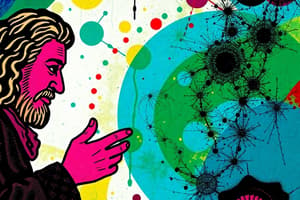Podcast
Questions and Answers
Who coined the term 'cell' or 'cellulae' after observing the honeycomb-like structures of cork?
Who coined the term 'cell' or 'cellulae' after observing the honeycomb-like structures of cork?
- Robert Hooke (correct)
- Zacharias Janssen
- Anton Van Leeuwenhoek
- Robert Brown
Who discovered tiny organisms (protozoa and bacteria) in pond water and called them 'animalcules'?
Who discovered tiny organisms (protozoa and bacteria) in pond water and called them 'animalcules'?
- Robert Hooke
- Anton Van Leeuwenhoek (correct)
- Robert Brown
- Matthias Schleiden
Which scientist is considered the 'father of Microscopy'?
Which scientist is considered the 'father of Microscopy'?
- Robert Hooke
- Anton Van Leeuwenhoek (correct)
- Robert Brown
- Zacharias Janssen
Who discovered the 'nucleus' inside the cell and termed it as such?
Who discovered the 'nucleus' inside the cell and termed it as such?
Which scientist proposed the theory 'omnis cellula e cellula', meaning 'every cell stems from another cell'?
Which scientist proposed the theory 'omnis cellula e cellula', meaning 'every cell stems from another cell'?
What can be characterized by changes in the anatomical structure of the cell?
What can be characterized by changes in the anatomical structure of the cell?
Flashcards
Who coined the term 'cell'?
Who coined the term 'cell'?
Robert Hooke, an English scientist, first used the term "cell" or "cellulae" to describe the honeycomb-like compartments he observed in cork tissue under a microscope.
Who discovered 'animalcules'?
Who discovered 'animalcules'?
Anton Van Leeuwenhoek, a Dutch scientist, discovered tiny living organisms in pond water, which he called "animalcules". These were later identified as protozoa and bacteria.
Who is known as the 'father of microscopy'?
Who is known as the 'father of microscopy'?
Anton Van Leeuwenhoek is widely recognized as the "father of microscopy" due to his groundbreaking contributions to the development and use of microscopes, which led to the discovery of microorganisms.
Who discovered the 'nucleus'?
Who discovered the 'nucleus'?
Signup and view all the flashcards
Who proposed the theory 'omnis cellula e cellula'?
Who proposed the theory 'omnis cellula e cellula'?
Signup and view all the flashcards
What can be characterized by changes in cell structure?
What can be characterized by changes in cell structure?
Signup and view all the flashcards
Study Notes
Microscope Development
- Zacharias Janssen invented the compound microscope, consisting of objective and eyepiece lenses.
- Anton Van Leeuwenhoek improved the design of the existing compound microscope.
Cell Discovery
- Robert Hooke observed honeycomb-like structures in cork, leading to the term "cell" or "cellulae".
- Anton Van Leeuwenhoek discovered tiny organisms (protozoa and bacteria) in pond water and called them "animalcules" in 1676.
- Robert Brown discovered that all plant specimens are composed of cells and found a dark, dense spot inside the cell, which he termed "nucleus".
- Matthias Schleiden discovered that plants are made up of cells.
- Theodor Schwaan observed animal cells.
Cell Theory
- Rudolf Virchow proposed that cells come from pre-existing cells with his theory "omnis cellula e cellula", meaning "every cell stems from another cell".
- According to Virchow's theory, entities that can cause disease can be characterized by changes in the anatomical structure of the cell.
Studying That Suits You
Use AI to generate personalized quizzes and flashcards to suit your learning preferences.




